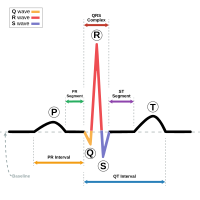
Photo from wikipedia
Purpose Depression is a common mental illness worldwide and has become an important public health problem. The current clinical diagnosis of depression mainly relies on the doctor’s experience and subjective… Click to show full abstract
Purpose Depression is a common mental illness worldwide and has become an important public health problem. The current clinical diagnosis of depression mainly relies on the doctor’s experience and subjective diagnosis, which results in the low diagnostic efficiency and insufficient objectivity of diagnostic results. Therefore, establishing a physiological and psychological model for computer-aided diagnosis is an urgent task. In order to solve the above problems, this article uses a convolutional neural network (CNN) to identify depression based on electrocardiogram (ECG). Methods Our method uses the raw ECG signal as the input of one-dimensional CNN, and uses the automatic feature processing layer of CNN to learn and distinguish signal features without additional feature extraction and feature selection steps. In order to obtain the optimal model, ECG segments of different durations (3 s, 4 s, 5 s and 6 s) and CNNs with different layers were used for comparison. In order to obtain modeling data, the resting ECG of 37 depression patients and 37 healthy controls were collected. In the proposed network, larger convolution kernels are used to better focus on overall changes. In addition, this article focuses on the inter-patient data classification standard, where the training and test sets come from different patient data. Results Through comprehensive comparison, the 5 s ECG segment and 5-layer CNN are recommended in related applications. The proposed approach achieves high classification performance with accuracy of 93.96%, sensitivity of 89.43%, specificity of 98.49%, positive productivity of 98.34%. Conclusion The experimental results indicate that the end-to-end deep learning approach can identify depression from ECG signals, and possess high diagnostic performance. It also shows that ECG is a potential biomarker in the diagnosis of depression.
Journal Title: Journal of Medical and Biological Engineering
Year Published: 2022
Link to full text (if available)
Share on Social Media: Sign Up to like & get
recommendations!